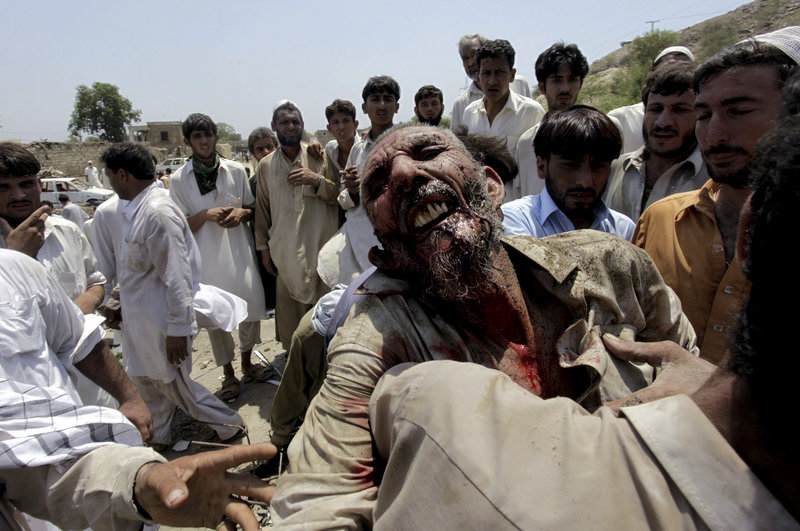PESHAWAR, Pakistan – A pair of suicide bombings killed 62 people Friday outside a government office in a region along the Afghan border where the Pakistani army and U.S. missiles have had some success in decreasing the number of such attacks.
The assault, which wounded at least 111 people, was one of the deadliest in Pakistan this year. There was speculation that the bombers were targeting anti-Taliban tribal elders visiting the government office in the village of Yakaghund, part of the Mohmand tribal area in the country’s northwest.
The attackers struck within seconds of each other as two U.S. senators met with Pakistani leaders in the capital, Islamabad, to discuss their countries’ cooperation in the fight against terrorism, much of it being waged in the lawless tribal belt bordering Afghanistan where al-Qaida and the Taliban have long had redoubts.
One of the bombs appeared fairly small but the other was huge, officials said. At least one bomber was on a motorcycle.
The bombers detonated their explosives near the office of Rasool Khan, a deputy Mohmand administrator who escaped unharmed. The tribal elders, including those involved in setting up militias to fight the Taliban, were in the building, but none was hurt, according to Mohmand chief administrator Amjad Ali Khan.
Video footage showed dozens of men searching through piles of yellow brick and mud rubble for survivors. Women and children were among the victims.
Abdul Wadood, 19, was sitting in a vehicle at the time.
“I only heard the deafening blast and lost consciousness,” said Wawood, who was being treated for head and arm wounds in Peshawar, the main city in the northwest, about 15 miles away. “I found myself on a hospital bed after opening my eyes. I think those who planned or carried out this attack are not humans.”
Some 70 to 80 shops were damaged or destroyed, while damage to a prison building allowed 28 prisoners — ordinary criminals, not militants — to flee, said Rasool Khan, who gave the casualty figures.
Near the attack site, officials had been distributing wheelchairs to disabled people and equipment to poor farmers, Amjad Ali Khan said. It was unclear how many participants in that event were among the victims.
Khan disputed reports that the aid was provided through U.S. funding, saying it came from Pakistani government funds.
However, U.S. Embassy spokesman Rick Snelsire confirmed that on the previous day Pakistani staff from a Washington-based contractor that receives USAID money had been giving out farm equipment in the village. The staff of that contractor, AED or Academy for Educational Development, were staying in the area, but were not believed to have been the targets Friday, Snelsire said.
Pakistani Taliban spokesmen could not be immediately reached after the attack. There were scattered reports that the militant group’s branch in Mohmand had claimed responsibility and said it was targeting the elders.
Mohmand is one of several areas in Pakistan’s lawless tribal belt where Taliban and al-Qaida members are believed to be hiding. The Pakistani army has carried out operations in Mohmand, but it has been unable to extirpate the militants. Its efforts to rely on citizen militias to take on the militants have had limited success there.
Nevertheless, there have been fewer attacks in Pakistan this year than in previous years, most notably in the northwest. In the last three months of 2009, more than 500 people were killed in a surge of attacks in the country.
Although information from the tribal belt is difficult to verify independently, the Pakistani army’s operations and U.S. missile strikes are believed to have calmed the situation since then.
The attacks that have occurred in 2010 have inflicted large numbers of casualties.
On New Year’s Day, a suicide car bomber struck a sports event near a meeting of tribesmen who supervise an anti-Taliban militia near the South Waziristan tribal area. At least 96 people were confirmed dead.
Copy the Story Link
Send questions/comments to the editors.



Success. Please wait for the page to reload. If the page does not reload within 5 seconds, please refresh the page.
Enter your email and password to access comments.
Hi, to comment on stories you must . This profile is in addition to your subscription and website login.
Already have a commenting profile? .
Invalid username/password.
Please check your email to confirm and complete your registration.
Only subscribers are eligible to post comments. Please subscribe or login first for digital access. Here’s why.
Use the form below to reset your password. When you've submitted your account email, we will send an email with a reset code.